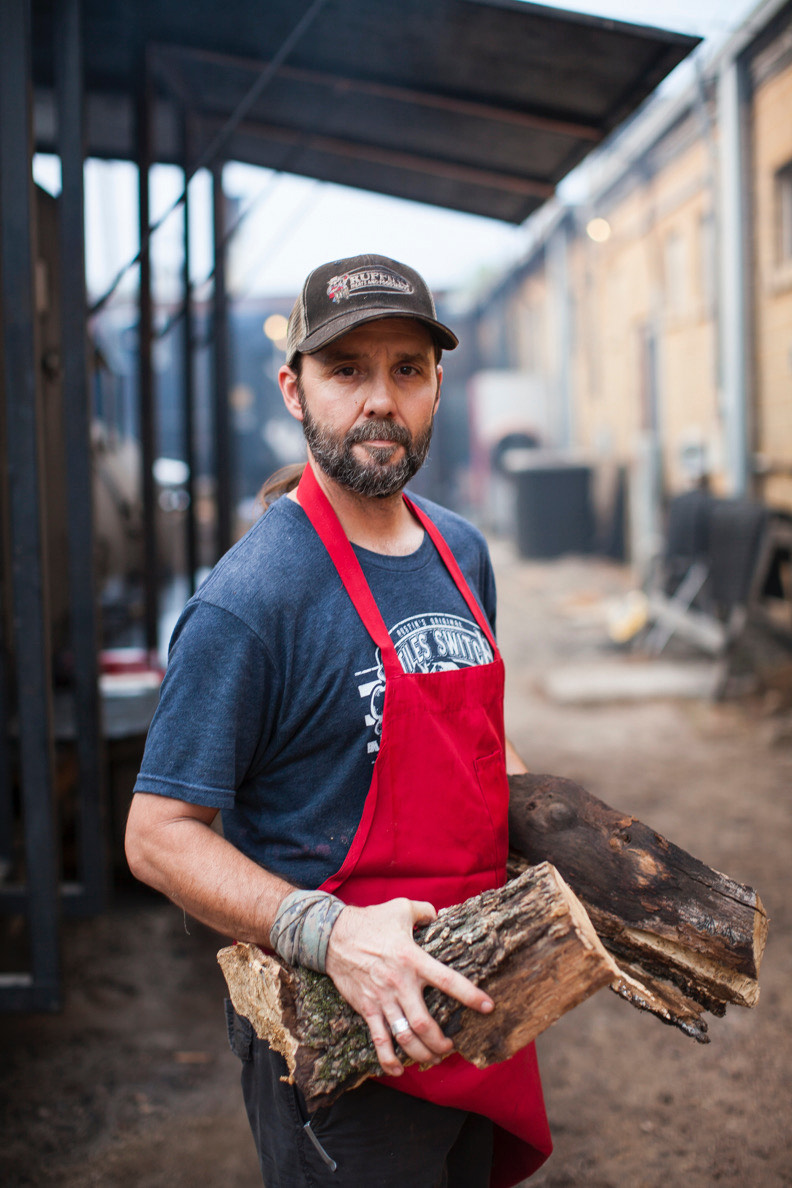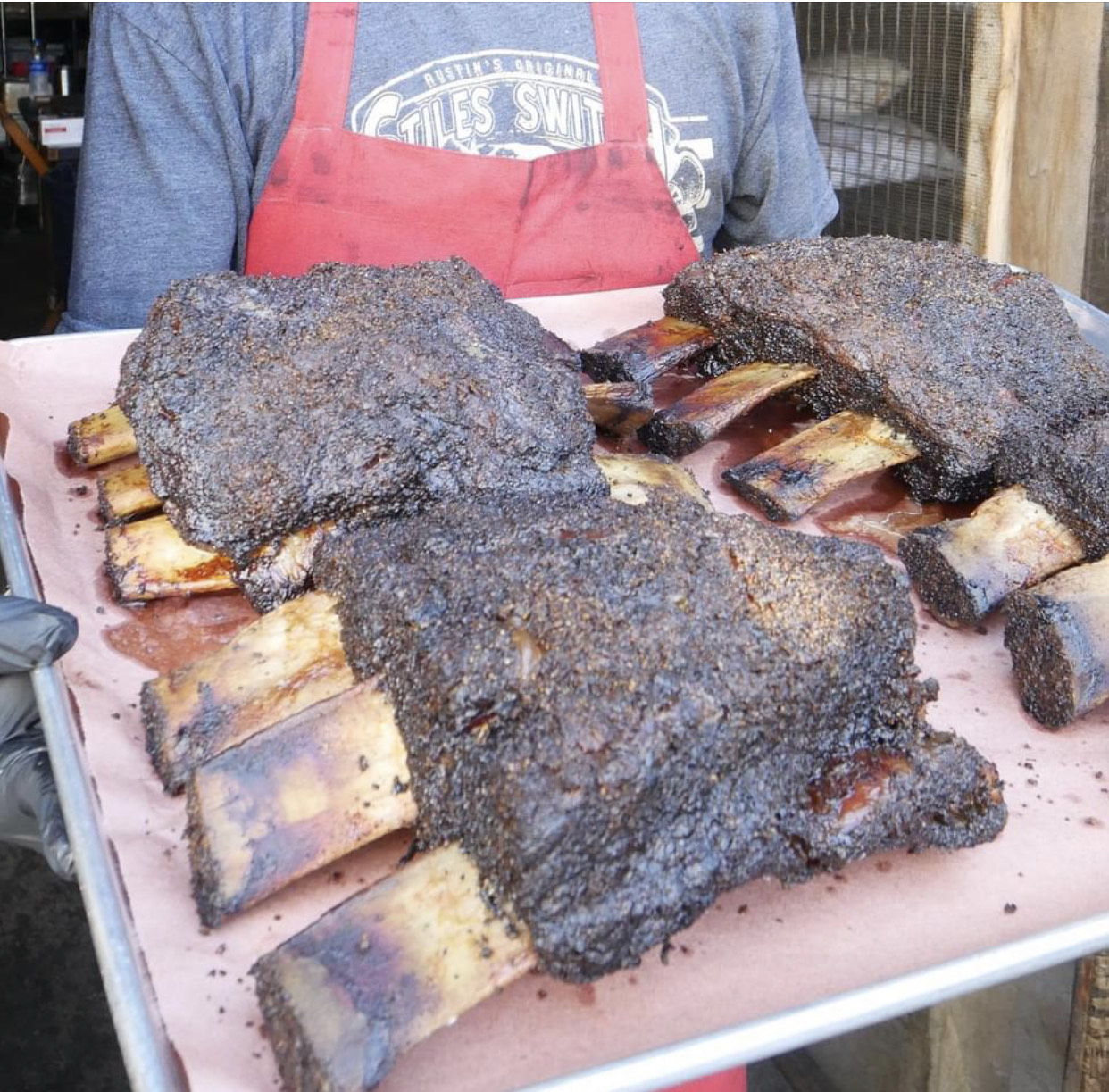Typically, when you hear a pitmaster’s introduction to the world of barbecue, tales of growing up around cooking and a passion for food come into play. This isn’t that type of story. Lance Kirkpatrick — lead pitmaster of Austin’s hottest barbecue joint, Stiles Switch BBQ & Brew — was working as a bartender before he learned his ‘cue expertise at the feet of the late, great Bobby Mueller.
Mueller, the legendary owner of Louie Mueller Barbecue in Taylor, Texas, just outside of Austin, was Kirkpatrick’s barbecue mentor — teaching him the importance of running a clean fire, along with so many other bits of expertise and nuance. The eight years Kirkpatrick spent working alongside the ‘cue legend no doubt shaped the upstart chef’s trajectory. Fast forward to the current day and it’s evident that Kirkpatrick has taken those teachings and fused them with his own hard-won knowledge and skill.
Though I initially went to Stiles Switch for the legendary brisket — which is phenomenal — it was Kirkpatrick’s Flintstone-esque beef ribs that left me completely mesmerized. Just check these beauties out:
After eating, I got the chance to learn a little more of Kirkpatrick’s story, along with what keeps him motivated. More to the point, he also divulged (a few of!) his secrets for the perfect rack of beef ribs.
***
What initially attracted you to barbecue? Did you always set out to be a pitmaster?
No. Really, I just I was looking to get out of bartending and I had cooked in other kitchens. I didn’t know anything about barbecue. I literally answered an ad in the paper to Louie Mueller Barbecue out in Taylor, where I was living, and I knew nothing about barbecue.
I learned everything, all the basics from Mr. Mueller there, Louie Mueller.
Yeah, I’m familiar. My husband is from Taylor. He used to eat there. So, I’m guessing was it Bobby Mueller that was your mentor?
He was my mentor. I worked with Bobby for a little over eight years.
Wow. So what would you say was the biggest tip or takeaway you took from being mentored by Bobby?
He would always just tell you to watch your fire and watch your meat. I heard those words over and over. Just running a good constant [and] even fire and not letting it dip or spike was one of his big mantras.
What would you say is the key to keeping a clean fire?
Good wood selection and good management of it. I’ve changed different styles over the years, I like to kind of teach now like gentle is the way with the fire kind of let the fire cook to its full potential. Each log kind of has a potential when you put it on. And sometimes you want to go in and break it down and rebuild but letting each log cook to full potential is something I try to do. Timing of when that fuel source and potential is waning to time another one to go on, where you can keep a constant level of temperature without spiking.
And you cook with post oak, right?
Yes, that is right.
What do you think that adds to the flavor profile of the barbecue?
Oak has a really unique characteristic with a lot of vanillas and sweetness to it. There’s a caramel kind of you can really smell the sweetness and taste the vanillas in there. There’s a reason for that, you know. They store good whiskies in charred oak barrels, and it gives it that kind of vanilla sweetness. They’ll put nice wines in charred oak barrels for that reason as well.
That makes sense. I write about whiskey quite a bit and that’s such a relatable parallel there.
Whiskey and barbecue kind of goes together.

What would you say keeps you motivated, or who keeps you motivated, to be the best you can be as a pitmaster?
I’ll credit Shane [Stiles] with that. He’s always pushing us to get a little outside of our comfort zone and maybe do a special that we hadn’t done before. I’m inspired by all the good cooks that we’ve hired over the ten years. We’ve been really fortunate to build some really good relationships with these guys. And we’re kind of known right now to have an all-star team. It’s true, we do. Over the three restaurants that we have, we’ve got six or eight just outstanding pit cooks working for us.
That’s my inspiration is to just, be an example for these guys we’ve got coming on and learn from some of these experienced guys that we’re bringing on. The customer inspires me a lot. You form a relationship with customers. It’s different in barbecue than any other restaurant. I think that it kind of keeps me coming back to the impact it has with the customer and that relationships that exchange from cook to the diner is really important to me.
You mentioned impact. With being a pitmaster, how do you feel that role has impacted you on a personal level?
It’s helped me. I’ve started to study Daoism a little after the time I started cooking. It’s helped me kind of become a better student of Daoism. There’s a lot of similarities in the way that you can cook – just metaphors of nature and letting things kind of evolve on their own; because a lot of what has to happen in that barbecue pit is a process of evolution. From a raw state, you’re using these elemental resources, like wood and raw meat, fire, and that all kind of comes together.
It’s taught me patience. It’s taught me self-awareness. I’m kind of a philosophical type of fellow and the overnight cooks kind of lend to that. The early morning hours by yourself and a lot of time for meditation and self-reflection and thought. On a real personal level, I’m sober from alcohol for seven years now and it really helped me get in a better place mentally and it helped me overcome my addiction to alcohol.

That is awesome. I’m glad to hear that and congratulations. Getting into the barbecue itself, as I mentioned before the interview, I know you’re known for your brisket. It’s exceptional. However, the beef ribs look like dinosaur bones — they were amazing! What’s the key to making the perfect beef ribs?
I see a lot of times folks just not cooking them long enough. That big beef rib is really a fairly easy cut of meat to cook, to be really honest.
It’s just again, running a good, clean fire and maybe cooking them a little hotter than you might think you want to, they can take a little bit of heat. I like to cook pork ribs around 265 to 275 jumping up a little hotter when they finish, but the bulk of the cook on those is around that.
The beef ribs, they’ll cook a little bit hotter, you can put them a little closer to your fire. Don’t be afraid to get a little bark on there. If it looks like it’s starting to burn a little bit. It might just be doing something that turns out to be okay.
I would just say keep it simple. Don’t try to overcomplicate with a lot of sauce. I don’t like to put sauce on beef anyway, but I just go with a dry rub on them. A lot of folks like just salt and pepper. We add a little house blend seasoned salt to our salt and pepper.
Just a good even temp and I do it by feel. I can put my hand around it with my thumb pressing down on the top portion of it. On those beef ribs, there’s a linear side where that blade kind of comes back. That’s where I always check, and I want my thumb to almost go through that. I want it soft enough for my thumb to really make an indentation. When I train people on cooking [beef ribs], I tell them you’re feeling for that bounce back, you don’t want that. You want to keep cooking it when you put your thumb in there and it bounces back a little, you want to keep cooking. You want a good give when you go to check it.
My last question pertains to Texas barbecue in general. I know that certain parts of Texas use mesquite or use post oak, for example. What would you say sets Texas barbecue or even Austin barbecue apart from other places in the country?
Maybe just the dry rub and the lack of sauce on the meat at the time of cook is one. Another is that it’s more of a beef-driven menu in Texas. Brisket and beef ribs are going to be at the forefront of every Texas barbecue. Whereas in Carolina, Georgia, etcetera — it’s probably going to be pulled pork or whole hog pork. I think what makes Texas unique, like you just said, is the different regionality to it with the different woods. Austin barbecue changed over the last five or ten years. I would say that even if you wanted to compare Austin barbecue to the rest of the state, you might be finding more examples of a chef-driven — not afraid to do different specials going outside of the normal menu of brisket, ribs, and sausage.







